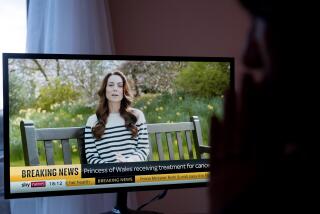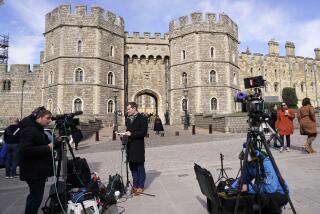Son shoots holes in ex-king’s hopes of returning to power in Nepal
- Share via
Reporting from Katmandu, Nepal — It’s tough being an unemployed king, especially when your son’s Wild West antics undermine any chance of getting your crown back.
This month, deposed Nepali King Gyanendra Shah, 63, watched those hopes go up in the smoke from his son’s pistol. In a fit of pique, wannabe-crown prince Paras Shah fired into the air at a hotel dinner, embarrassing the family after months of carefully scripted appearances by father and son.
“The resort incident has once again reminded the Nepali people that their former crown prince is still a trigger-happy guy, someone who cannot control himself once he is under the influence,” the Republica newspaper wrote. “Happy hibernation ahead, Paras!”
After the shot heard round Katmandu, the prince issued a statement justifying on the grounds of patriotism his showdown with relatives of a deputy prime minister, a family he reportedly blames for introducing democracy two years ago after 239 years of monarchy.
“I could not bear the insult of myself and the country,” Paras said.
No one expects him to serve time for allegedly firing an unregistered weapon and threatening people in a public place. But the fact he was even questioned — after renting a helicopter to travel to his brief detention — is seen as progress.
Things were a lot easier for bad boy Paras, who once roared around on Nepal’s only Harley-Davidson, when royal immunity kept him above the law.
When his SUV hit a popular singer riding a motorbike in 2000, Paras reportedly sped to the police station — not to report the accident but to warn the officer on duty against doing so, allegedly at gunpoint. Public outrage followed, to no avail.
According to news reports, Paras also jammed the butt of a gun into the eye of a policeman who stopped his car in 1999; fired several shots airborne at a nightclub during a tiff with his wife in 2004; and assaulted a policeman after rocks were thrown at the king’s motorcade in 2005.
“The latest incident shows his bad habits haven’t changed much,” said Madhav Prashad Bhattarai, 42, a lawyer.
Although most observers say Nepal is too wedded to democracy for a return of the monarchy, the recent wrangling among politicians — there’ve been more than a dozen attempts since June to name a prime minister — had given royalists fresh hope.
“Protracted political problems play into Gyanendra’s hands,” said Binod Bhattarai, a journalist and political analyst. “He doesn’t have to do much. Others do it for him.”
Until the shooting derailed it, Gyanendra and Paras were on a charm offensive, at one point visiting 10 temples in two days in a country that once saw the monarch as a divine incarnation. “Our king, our country, dearer than our soul,” supporters cried.
The king “used the pilgrimages to gauge the public’s [political] mood,” said Ram Sharan Mahat, a leader of the Nepali Congress party.
Paras, 39, also cut off his ponytail and expressed regret for his past “mistakes and sins,” and his wife, Himani, recently started a charity and reportedly stopped wearing a naval ring.
The family evokes nostalgia in some quarters. “I don’t think the monarchy is over,” said Khemraj Uprety, 42, a salesman. “They’re still in the hearts of the people.”
Members of the royal family and their inner circle declined repeated requests for an interview, but learning on the job has been a necessity for a branch that never expected to serve. Businessman Gyanendra acceded to power unexpectedly in 2001 after his gun-loving royal nephew massacred several family members, including the king and queen, before shooting himself.
Gyanendra’s perceived arrogance and a 2005 grab for absolute power turned the public against him. In 2008, parliament made it official, giving him two weeks to vacate the palace.
“He was an idiot king who thought Nepal was his property,” said Kanak Mani Dixit, editor of Himal Southasian Magazine. “He was a fool.”
Behind Katmandu’s Narayanhiti Palace, now a museum, all that remains of the murder site are outlines of razed buildings and a few makeshift signs.
The boxy 1960s-era palace hints at the life the wannabe royals hope to recapture. Among the royal personal effects on display include numerous Hummel-style porcelain figurines of happy Swiss peasants, smiling Bo Peeps (with their sheep) and a naked woman (petting a dog), along with such self-educational classics as “1001 Wonderful Things” and “World’s Greatest Paintings.”
“Our monarchy was marvelously tin-pot; it makes the British look like saints,” said Manjushree Thapa, author of “Forget Katmandu: An Elegy for Democracy.” “It’s a really ticky-tacky little palace.”
During the June 2001 massacre, Gyanendra was in Nepal’s second city of Pokhara, while Paras escaped unscathed in the palace, fueling conspiracy theories. Rumors flew that the “real killer” wore a rubber mask to look like the nephew and then boarded a helicopter for Pokhara, conclusions an investigating commission rejected.
“If you in the West still have questions about [Lee Harvey] Oswald, [Jack] Ruby, [Princess] Diana, then imagine Nepal, a place unable to speak truth to populism,” said Dixit, the editor, who accepts the official view of the massacre at face value. “Everyone loves a good conspiracy.”
These days, the unemployed king struggles to adjust to ordinary life. A few months ago, he told a television station that he had been enduring up to 12 hours of blackouts each day in his tin-roofed hunting lodge, like everyone else, and must pay his own utility bills.
Bhekh B. Thapa, a former foreign minister and the father of author Manjushree Thapa, said he had served three kings, and that the last one never listened to anyone. Still, he said, it must be a psychologically difficult transition.
“I can’t put myself in his shoes,” he said. “I never had that kind of power or wealth. There’s always the next life, though. We believe in reincarnation.”
Special correspondent Rajneesh Bhandari contributed to this report.
More to Read
Sign up for Essential California
The most important California stories and recommendations in your inbox every morning.
You may occasionally receive promotional content from the Los Angeles Times.










